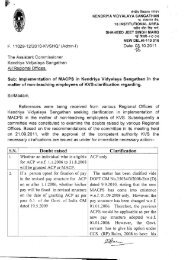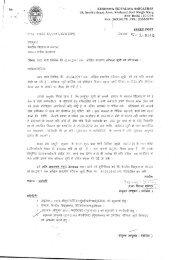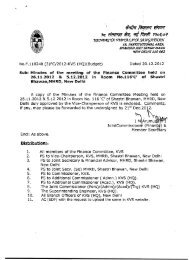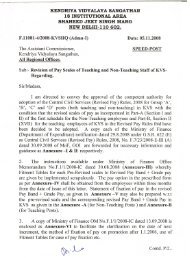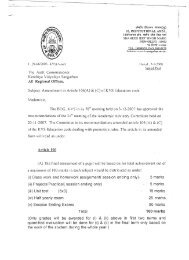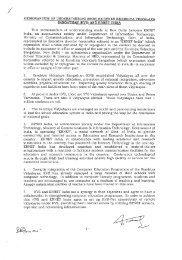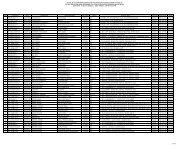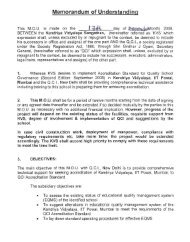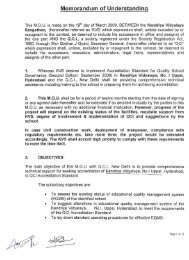Syllabus for written examination for PGT (Biology)
Syllabus for written examination for PGT (Biology)
Syllabus for written examination for PGT (Biology)
Create successful ePaper yourself
Turn your PDF publications into a flip-book with our unique Google optimized e-Paper software.
<strong>Syllabus</strong> <strong>for</strong> <strong>written</strong> <strong>examination</strong> <strong>for</strong> <strong>PGT</strong> (Phy)Unit I: Physical World and MeasurementNeed <strong>for</strong> measurement: Units of measurement; systems of units; SI units, fundamentaland derived units. Length, mass and time measurements; accuracy and precision ofmeasuring instruments; errors in measurement; significant figures.dimensional analysis and its applications.Unit II: KinematicsFrame of reference. Motion in a one ,two and three dimension: Position-time graph, speed andvelocity.Uni<strong>for</strong>m and non-uni<strong>for</strong>m motion, average speed and instantaneous velocity.Uni<strong>for</strong>mly accelerated motion, velocity-time, position-time graphs, relations <strong>for</strong> uni<strong>for</strong>mlyaccelerated motion .Vectors :Position and displacement vectors .addition and subtraction ofvectors. Relative velocity.scalar product of vectors,Vector product of vectors.Unit vector; Resolution of a vector in a plane - rectangular components. Motion in aplane. Cases of uni<strong>for</strong>m velocity and uni<strong>for</strong>m acceleration-projectile motion.Unit III: Laws of MotionIntuitive concept of <strong>for</strong>ce. Inertia, Newton’s first law of motion; momentum and Newton’ssecond law of motion; impulse; Newton’s third law of motion. Law of conservation oflinear momentum and its applications.Equilibrium of concurrent <strong>for</strong>ces. Types of friction, laws of friction, .Dynamics of uni<strong>for</strong>mcircular motion .Unit IV: Work, Energy and PowerWork done by a constant <strong>for</strong>ce and a variable <strong>for</strong>ce; kineticenergy, work-energy theorem, power.Notion of potential energy, potential energy of a spring, conservative <strong>for</strong>ces: conservationof mechanical energy (kinetic and potential energies); non-conservative <strong>for</strong>ces: elasticand inelastic collisions in one and two dimensions.Unit V: Motion of System of Particles and Rigid BodyCentre of mass of a two-particle system, momentum conversation and centre of massmotion. Centre of mass of a rigid body; centre of mass of uni<strong>for</strong>m rod.; moment of a <strong>for</strong>ce, torque, angular momentum, conservationof angular momentum with some examples.Dynamics of rigid bodies, comparison of linear and rotational motions; moment of inertia,radius of gyration.Values of moments of inertia <strong>for</strong> geometrical objects. Parallel and perpendicular axis theoremsand their applications.Unit VI: GravitationKeplar’s laws of planetary motion. The universal law of gravitation.Variation of Acceleration due to gravity and with altitude,latitude and depth.Gravitational potential energy; gravitational potential. Escape velocity. Orbital velocityof a satellite. Geo-stationary satellites.Unit VII: Properties of Bulk MatterElastic behaviour, Stress-strain relationship, Hooke’s law,modulus of elasticity .Pressure due to a fluid column; Pascal’s law and its applicationsViscosity, Stokes’ law, terminal velocity, Reynold’s number, streamline and turbulentflow. Bernoulli’s theorem and its applications.Surface energy and surface tension, application of surface tension ideasto drops, bubbles and capillary rise.Heat, temperature, thermal expansion; specific heat - calorimetry; change of state - latentheat.Heat transfer-conduction, convection and radiation, thermal conductivity, Newton’s lawof cooling.Unit VIII: ThermodynamicsThermal equilibrium and definition of temperature (zeroth law of thermodynamics). Heat,work and internal energy. First law of thermodynamics.Second law of thermodynamics: reversible and irreversible processes. Heat engines andrefrigerators.carnot cycle and carnot’s theorem.Equation of state of a perfect gas, work done on compressing a gas.Kinetic theory of gases ,degrees of freedom, law of equipartition of energy and application tospecific heats of gases; concept of mean free path, Avogadro’snumber.Unit IX: Oscillations and WavesPeriodic motion - period, frequency, displacement as a function of time. Periodicfunctions.Simple harmonic motion (S.H.M) and its equation; phase; oscillations of a spring–restoring <strong>for</strong>ce and <strong>for</strong>ce constant; energy in S.H.M.-kinetic and potential energies; simplependulum–derivation of expression <strong>for</strong> its time period; free, <strong>for</strong>ced and damped oscillations,resonance.Wave motion. Longitudinal and transverse waves, speed of wave motion. Displacementrelation <strong>for</strong> a progressive wave. Principle of superposition of waves, reflection of waves,



